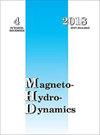Effect of the anode to cathode surface area ratio on the concentration distribution near the solid-liquid interface
IF 0.3
4区 工程技术
Q4 MECHANICS
引用次数: 0
Abstract
For the solid-liquid chemical reaction, the mass transfer near the solid-liquid interface is often the rate determining step, such as in an electroplating process and in a high temperature process. To enhance the chemical reaction, traditional methods reduce the concentration boundary layer thickness formed near the solid-liquid interface by exciting a macro-scale flow in the bulk region. However, traditional methods have limitation in reducing the concentration boundary layer, because the concentration boundary layer exists in the velocity boundary layer. This means that the excitation of flow in the concentration boundary layer is important. Based on this concept, direct imposition of a force near the solid-liquid interface by superimposing the magnetic field and current has been proposed. By this means, the flow can be directly excited in the concentration boundary layer. In the past research, a Cu anodic electrode was dissolved in a Cu2+ aqueous solution, and the increase of the Cu2+ concentration decreased under the imposition of a time-varying force compared to that without the time-varying force imposition just above the centre of the anode. In this experiment, the uniformity of the solute concentration distribution under the time-varying force imposition with a different anode to cathode surface area ratio was investigated. As a result, the uniformity of the Cu2+ concentration distribution increased, and the average Cu2+ concentration in the vicinity of the anode surface decreased by increasing the anode to cathode surface area ratio. Tables 2, Figs 3, Refs 13.阳极阴极表面积比对固液界面附近浓度分布的影响
对于固液化学反应,固液界面附近的传质往往是决定反应速率的步骤,例如在电镀过程和高温过程中。为了增强化学反应,传统的方法是通过在体区激发宏观尺度的流动来减小固液界面附近形成的浓度边界层厚度。然而,由于浓度边界层存在于速度边界层中,传统的方法在降低浓度边界层方面存在局限性。这意味着在浓度边界层中激发流动是重要的。基于这一概念,提出了在固液界面附近通过叠加磁场和电流直接施加力的方法。通过这种方法,可以在浓度边界层中直接激发流动。在以往的研究中,将Cu阳极电极溶解在Cu2+水溶液中,在施加时变力的情况下,与不施加时变力的情况相比,在阳极中心上方施加时变力时,Cu2+浓度的增加幅度减小。在本实验中,研究了不同阳极阴极表面积比下,随时间变化的力作用下溶质浓度分布的均匀性。结果表明,随着阳极与阴极表面积比的增大,Cu2+浓度分布的均匀性增加,阳极表面附近的平均Cu2+浓度降低。表2,图3,参考文献13。
本文章由计算机程序翻译,如有差异,请以英文原文为准。
求助全文
约1分钟内获得全文
求助全文
来源期刊

Magnetohydrodynamics
物理-力学
CiteScore
1.20
自引率
14.30%
发文量
37
审稿时长
6-12 weeks
期刊介绍:
Information not localized
 求助内容:
求助内容: 应助结果提醒方式:
应助结果提醒方式:


